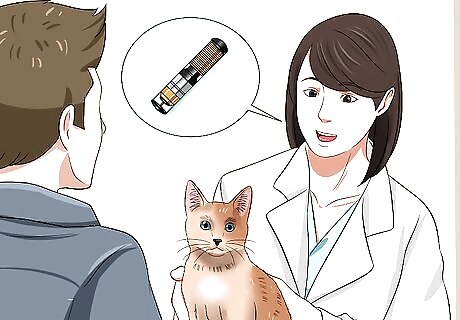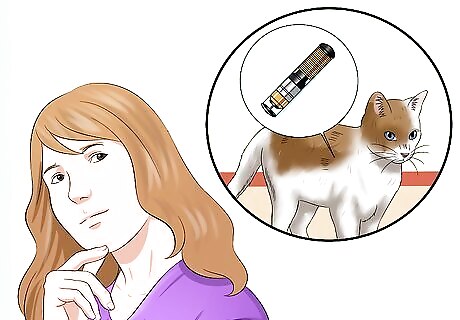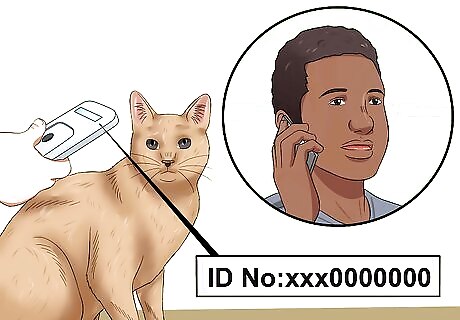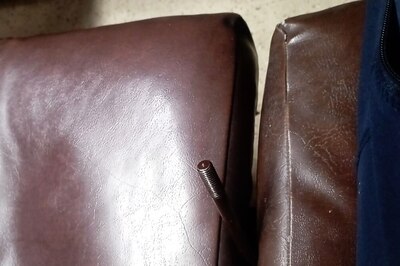
views
Obtaining the Microchip

Avoid microchipping your cat on your own. Never inject your cat with a microchip on your own. This is illegal in many states and can cause you to have legal measures taken against you. There are sellers who will sell you a microchip without going through a veterinary office, but you should never implant these devices yourself. Take these to your vet to have them checked out and implanted in the right way.

Visit the vet. When you decide it is time for your cat to be microchipped, take him to the vet. Qualified veterinary professionals should always administer microchips to your cat. They know exactly how much pressure to use, where to place the microchip, and how to combat the rare chance of side effects. Since your cat is smaller than other animals, it is important that the microchip is injected in the right place to avoid issues.

Complete the paperwork. When you go to the vet to have your cat microchipped, complete the paperwork that goes along with the microchip. The paperwork acts as the registration form for the manufacturer's database, such as Homeagain, once it is sent in by the vet. Ensure that all of your contact information is correct so the database has the right information for you. Always obtain copies of the microchip paperwork for your records. This will help you keep track of your unique ID number and manufacturer information attached to the microchip. There might be a registration fee for the database, but the microchip is worthless without the registration.

Verify ID number on the microchip. While your vet is preparing to inject your cat with the microchip, she will verify the unique ID of the chip matches the paperwork you have. She will run the microchip reader over the chip inside the applicator and make sure the reading is correct. This also checks to make sure the microchip is emitting properly before it is injected in your cat.

Have an assistant secure your cat. You will be in a normal exam room when your cat is injected with the microchip. This procedure requires two people, one being an assistant who will secure your cat. The assistant should hold your cat by the scruff of her neck, which is the skin right on the neck. He should also hold your cat's rear end steady with his other hand. This will keep your cat from jerking when the microchip is injected.

Have the vet perform the microchip administration. Once your cat is secured by the vet assistant, your vet will find the right area between your cat's shoulder blades for the microchip. She will then tent the skin of your cat's back and press the applicator to the area, implanting the microchip under the skin. The microchip is around the size of a grain of rice, so it shouldn't cause too much pain. Your cat's skin around the injection site doesn't need to be sterilized as long as he is clean.

Verify the microchip again. After microchip administration, your vet will verify the microchip is still working. This will ensure that nothing went wrong with the microchip during implantation. She will run the reader over the implantation site to check that your unique ID is still emitted from the microchip. When your cat goes in for his yearly checkup, your vet will likely recheck the device to make sure nothing has gone wrong with it.

Update your information. In order for your cat to be returned to you, your contact information in the microchip manufacturer's database needs to be up to date. If you change your phone number, move, or have any other contact information change, you need to contact the database to let them know. This way, they can update your information to reflect your new situation.
Deciding to Get a Microchip

Discover why microchips matter. If you microchip your cat, there is an increased chance of your cat being returned to you if he runs off. Breakaway collars, which are the type that should be used on cats, can break off easily, but microchips are permanent forms of ID once they are implanted.

Learn a microchip's longevity. Microchips last a long time and do not need to be charged or replaced. They require no power because they just bounce information to a scanner. This means that the microchip will last for the entire span of your cat's life, unless the chip malfunctions for some reason. This means that you only have to implant your cat once.

Consider how a microchip functions. Microchips are devices that use radio wave emissions to project a unique ID number for your cat. There are three different frequencies that can be used, but most veterinary offices, shelters, and rescues have universal microchip readers which allow them to read all different emissions. When a vet, shelter, or rescue checks a microchip, the cat's unique ID and the manufacturer of the chip are displayed. From this information, the person that found your cat can contact the database to find out your information. This also means that your contact information is safe from others unless they have access to the microchip database.

Determine the cost of microchips. On average, vets charge between $25 and $50 for microchip administration. This may vary depending on the price of your vet and if you get it done in conjunction with other procedures.

Discover microchips don't affect your cat's health. Microchips cause very few side effects. Only 391 cases of any side effects have been reported out of four million documented cases of animal microchipping. Pain is felt when the microchip is injected, but it is slight. There may be a little more pain for cats because they are smaller and have less padding than other animals. Your cat may react to a certain degree to the injection, but the pain is similar to that associated with any shot. If you are worried about the pain associated with the procedure, consider having your cat's microchip put in when he is neutered (or spayed if female). This is commonly done so as to avoid an extra office visit and to save your cat from even the slight pain associated with it. The rare extreme side effects are microchip migration that leads to abscesses or, in one case, cancerous tumor growth around the microchip.




















Comments
0 comment